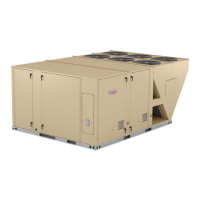Page 35
III-STARTUP - OPERATION
Refer to startup directions and to the unit wiring diagram
when servicing. See unit nameplate for minimum circuit
ampacity and maximum fuse size.
A-Cooling Startup See figure 7 for unit
refrigerant circuits
NOTE-Crankcase heaters must be energized 24 hours be
fore attempting to start compressor. Set thermostat so that
there is no demand to prevent compressor from cycling.
Apply power to unit.
1- Initiate first and second stage cooling demands ac
cording to instructions provided with thermostat.
4. First-stage thermostat demand will energize indoor
blower in Low Cooling CFM. Second-stage thermo
stat demand will energize indoor blower in High Cool
ing CFM. Both demands energize compressor 1
(variable speed compressor). The remaining com
pressors will be energized to modulate the discharge
air temperature.
5. 156, 180-
Units contain three refrigerant circuits or systems.
210, 240, 300 -
Units contain four refrigerant circuits or systems.
6. Each refrigerant circuit is separately charged with
R410A refrigerant. See unit rating plate for correct
amount of charge.
7. Refer to the Refrigerant Check and Charge section to
check refrigerant charge.
IV- SYSTEMS SERVICE CHECKS
A-Preliminary and Seasonal Checks
1- Make sure the unit is installed in accordance with the
installation instructions and applicable codes.
2- Inspect all electrical wiring, both field and factory installed
for loose connections. Tighten as required. Refer to unit di
agram located on inside of unit control box cover.
3- Check to ensure that refrigerant lines are in good
condition and do not rub against the cabinet or other
refrigerant lines.
4- Check voltage. Voltage must be within the range listed
on the nameplate. If not, consult power company and
have the voltage corrected before starting the unit.
5- Recheck voltage and amp draw with unit running. If
voltage is not within range listed on unit nameplate,
stop unit and consult power company. Refer to unit
nameplate for maximum rated load amps.
6- Inspect and adjust blower belt (see section on Blower
Compartment - Blower Belt Adjustment).
B-Cooling System Service Checks
LCM units are factory charged and require no further adjust
ment; however, charge should be checked periodically using
the approach method. The approach method compares actual
liquid temperature with the outdoor ambient temperature. See
section II- CHARGING.
V-MAINTENANCE
Electric shock hazard. Can cause injury or
death. Before attempting to perform any
service or maintenance, turn the electrical
power to unit OFF at disconnect switch(es).
Unit may have multiple power supplies.
WARNING
!
A-Filters
LCM units use six 24 X 24 X 2” fiberglass throw-away type
filters. Filters may be accessed through the economizer /
filter access door. Filters should be checked monthly (or
more frequently in severe use) and cleaned or replaced
regularly. Take note of the “AIR FLOW DIRECTION”
marking on the filter frame when re-installing.
B-Lubrication
All motors and blower wheels used in LCM units are lu
bricated; no further lubrication is required.
C-Supply Air Blower Wheel
Annually inspect supply air blower wheel for accumulated
dirt or dust. Turn off power before attempting to remove ac
cess panel or to clean blower wheel.
D-Evaporator Coil
Inspect and clean coil at beginning of each season. Clean
using mild detergent or commercial coil cleanser. Check
condensate drain pan and line, if necessary. Flush coil and
condensate drain with water taking care not to get insula
tion, filters and return air ducts wet. Check connecting
lines and coil for evidence of oil and refrigerant leaks.
E-Condenser Coil
Clean condenser coil annually with detergent or commer
cial coil cleaner and inspect monthly during the cooling
season. Check connecting lines and coil for evidence of
oil and refrigerant leaks.
F-Electrical
1- Check all wiring for loose connections.
2- Check for correct voltage at unit (unit operating).
3- Check amp-draw on both condenser fan motor and
blower motor.
Fan Motor Rating Plate ____ Actual ________
Indoor Blower Motor Rating Plate____ Actual____

